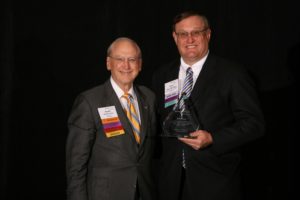People know the name Andre Lacy – and for good reason. Lacy’s name has adorned the business school at Butler University the last few years, but his career as an accomplished business owner and philanthropist in his hometown of Indianapolis is legendary.
Yesterday’s Indianapolis Star captured Lacy’s impact following his sudden death from injuries sustained in a motorcycle accident while he was in southern Africa.
“It’s a very sad day for us. Andre was a personal mentor and a dear friend to the Indiana Chamber,” offers Indiana Chamber President and CEO Kevin Brinegar.
Lacy’s involvement with the Chamber stretches back decades. He joined the organization’s board of directors in 1984 and his family’s wholesale distribution company, LDI Ltd., has been a member of the Chamber since 1941.
Lacy was chairman of the board of directors in 2008. During his time at the helm, he encouraged the organization to continue improving, enhanced good governance practices and pushed the organization to elevate its public policy efforts to an even higher level.
He was also chosen as a Chamber Volunteer of the Year in 2008. Lacy was quoted in BizVoice® on the importance of business in the lives of Hoosiers: “Business is not a dirty word. Business is the means for you to pay your mortgage. It is the means that you can take a vacation. It is the means that you can pay for your children’s education … and sometimes to splurge. Business is the big engine (for all that).”
Read the full story in BizVoice® from that time.
Additionally, Lacy was instrumental with the Chamber’s political action committee, Indiana Business for Responsive Government (IBRG), helping establish a matching grant program. He was also well known for his involvement with the Indiana State Fair and many other philanthropic endeavors in the Indianapolis area.
“Andre was one of a kind. His determination, spirit and will to help the business community was on another level – and he showed that same passion in giving back to his community and state,” Brinegar states.

Andre Lacy receives his Volunteer of the Year award in 2008 from Indiana Chamber President Kevin Brinegar.

 The Indianapolis Business Journal’s blog, The Score, posted an interesting piece today, contending the many changes at the Indianapolis Motor Speedway have things moving in the right direction. Among those, its focus on giving more value and opportunity to its corporate partners is targeted as a momentum shifter. What’s more, it mentions that our former chairman, Andre Lacy, is now playing a prominent role on the Speedway’s board.
The Indianapolis Business Journal’s blog, The Score, posted an interesting piece today, contending the many changes at the Indianapolis Motor Speedway have things moving in the right direction. Among those, its focus on giving more value and opportunity to its corporate partners is targeted as a momentum shifter. What’s more, it mentions that our former chairman, Andre Lacy, is now playing a prominent role on the Speedway’s board. Our Chairman of the Board, Andre Lacy, provides
Our Chairman of the Board, Andre Lacy, provides  Our Chairman of the Board, Andre Lacy, offers
Our Chairman of the Board, Andre Lacy, offers